

Sky Farm by Gordon Graff. For our second installment of six architectural projects dedicated to vertical farming, renewable energies, and the construction of a better, greener 21st century, s.a.johnson discusses the Sky Farm project by Gordon Graff.

While a Masters of Architecture student at Waterloo University, Gordon Graff developed the concept for a 58-story agricultural tower called the Sky Farm. Its 8 million square feet of growing area, equal to over 180 acres, has the potential to provide enough food for 35,000 citizens per year. Growing Skyscrapers: The Rise of Vertical Farms. Together the world’s 6.8 billion people use land equal in size to South America to grow food and raise livestock—an astounding agricultural footprint.
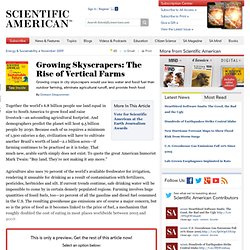
And demographers predict the planet will host 9.5 billion people by 2050. Because each of us requires a minimum of 1,500 calories a day, civilization will have to cultivate another Brazil’s worth of land—2.1 billion acres—if farming continues to be practiced as it is today. That much new, arable earth simply does not exist. To quote the great American humorist Mark Twain: “Buy land. The Vertical Farm Project - Agriculture for the 21st Century and Beyond. 1 Million Pounds of Food Per Acre?! Ultra High Yield Solar Powered Vertical Aquaponics System.
MISSION STATEMENT & PROJECT GOAL: Build an aquaponics system which maximizes crop yield per square foot and share that design under an OPEN SOURCE license for anyone to improve upon, modify, and use for producing organically grown food in their local area.
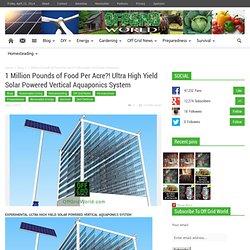
The ultimate goal of building and improving this system is getting as close as possible to an annual crop yield of 1 Million pounds of organically grown food per acre. UP TO 20 TIMES THE CROP YIELD PER SQUARE FOOT (or more): I’ve designed a self contained vertical aquaponics system which MAXIMIZES the annual food yield per square foot of land to 20 times or more than traditional flat farming row crops. 100sqft FOOTPRINT: Each module covers a horizontal area of only 100sqft which means almost anyone can build one of these modules in their back yard without taking up much space at all. 2000sqft VERTICAL GROW AREA: Each module has a vertical grow area of 2000 square feet.
Is a 60-storey skyscraper the farm of the future? How to get local produce in the city?
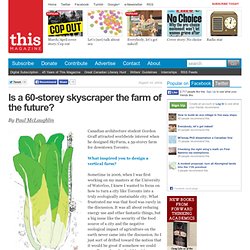
Look up. Illustration by Peter Mitchell. Canadian architecture student Gordon Graff attracted worldwide interest when he designed SkyFarm, a 59-storey farm for downtown Toronto. Incorporating Urban Agriculture into Urban Planning: The Tale of Three Cities. A comparative study: Urban Agriculture in Vancouver, Dar es Salaam and Copenhagen Independent Study by Afton Halloran University of Copenhagen Faculty of Life Science Jan 21, 2011 Abstract Although generally thought of as a livelihood strategy for the urban poor in developing countries, urban agriculture is prevalent in both the global South and North.

Urban agriculture has been heralded for its environmental, social and economic benefits. However, in some cities it is an unrecognized practice and some typologies of urban agriculture are even treated as illegal. Urban planning has an important influence in determining the structure of a city. This paper argues that urban planners are important stakeholders, which influence the successfulness urban agriculture legitimization and its incorporation into the urban environment. 9. With increased urbanization and global food insecurity on the rise cities around the world are looking for solutions. FUTURE FARMS: High-Rise, Beach Pod, and Pyramid Pictures.
Can Urban Farming Go Corporate? Farms have sprouted in cities across the country over the past several years as activists and idealists pour their sweat into gritty soil. Vertical farming: Does it really stack up? WHEN you run out of land in a crowded city, the solution is obvious: build upwards.
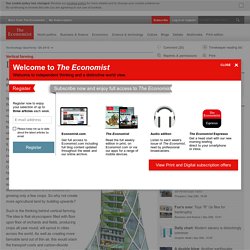
This simple trick makes it possible to pack huge numbers of homes and offices into a limited space such as Hong Kong, Manhattan or the City of London. Mankind now faces a similar problem on a global scale. The world's population is expected to increase to 9.1 billion by 2050, according to the UN. Feeding all those people will mean increasing food production by 70%, according to the UN's Food and Agriculture Organisation, through a combination of higher crop yields and an expansion of the area under cultivation. The 8 Most Interesting Ideas to Revolutionize Urban Farms. Today, while the Center for Science in the Public Interest was busy coordinating Food Day events across the nation, we got to thinking about all the delicious plants that will have to grow on buildings if our rapidly urbanizing world is to produce enough sustenance for the projected 9.1 billion people who will need access to fresh food by 2050.
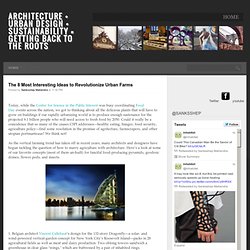
Could it really be a coincidence that so many of the causes CSPI addresses—healthy eating, hunger, food security, agriculture policy—find some resolution in the promise of agritecture, farmscrapers, and other utopian portmanteaus? We think not! As the vertical farming trend has taken off in recent years, many architects and designers have begun tackling the question of how to marry agriculture with architecture. Here’s a look at some of our favorite concepts (most of them un-built) for fanciful food-producing pyramids, geodesic domes, flower pods, and insects. 1. 2. 3. 4.
Vertical Farms and Green Cities. Farming the Cities, Feeding an Urban Future. WASHINGTON - June 16 - As people move from rural to urban settings in search of economic opportunities, urban agriculture is becoming an important provider of both food and employment, according to researchers with the Worldwatch Institute.

"Urban agriculture is providing food, jobs, and hope in Nairobi, Kampala, Dakar, and other cities across sub-Saharan Africa," said Danielle Nierenberg, co-director of the Institute's Nourishing the Planet project. "In some cases, urban farmers are providing important inputs, such as seed, to rural farmers, dispelling the myth that urban agriculture helps feed the poor and hungry only in cities. " The United Nations projects that up to 65 percent of the world's population will live in cities by 2050, up from around 50 percent today. The rate of urban migration is particularly high in sub-Saharan Africa and South Asia, where inadequate urban infrastructure struggles to keep up with the large influx of people. Beehive Tower is a Honeycomb Inspired Vertical Farm for London. The aim of the Beehive Tower is to provide the Canary Wharf community of city dwellers a place to garden and live.

The tower’s hexagonal mega structural lattice contains greenhouse spaces that also serve as a place for people to meet and socialize. Each hexagon is 8 stories high and contains 8 duplex apartments.